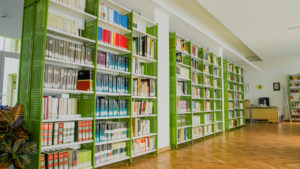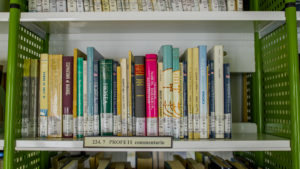Its establishment (1947) followed the humble but steady development of the Adventist Institute of Biblical Culture- Villa Aurora (IACB- VA). In its early configurations it consisted of a couple of rooms located, first in the men’s boarding school, then in the women’s boarding school of Villa Aurora. The writer of these notes attended both in the 1970s.
The shelves were solid wood, dark, reassuringly high to the ceiling.
These shelves lasted (still exist) until 2014, when there was the breakthrough of the new library, professionally furnished and located in the brand new facility Vacation Home “Aurora,” a building constructed within an area owned by the historic “Villa Aurora.”
But before this happy development, there was an intermediate phase that saw the library occupy three spacious rooms within a building constructed in the early 1990s that still houses the FAT and the Italian Languages and Culture Department.
The founding and development of the library is the result of the turnover of a not insignificant number of managers and staff members who have operated thanks to the support of the 7th Day Adventist Christian Church, which, with both institutional funds and individual donations, has brought the fund to more than 20,000 volumes.
This figure will certainly appear modest when compared to those of other sister entities, but it is not negligible when some typical elements are taken into account. The FAT library, while having books in its catalog covering different disciplines of study, remains characterized by a clear concentration on biblical sciences and theology. Because of its long history, there are genuine “pearls” in the catalog, especially in the area of church history and Christianity. In 2007, recognizing the value of antiquarian book safekeeping and preservation, a room was dedicated to valuable works, whose numbering (CDD) starts from 001, effectively constituting a library within a library. These bibliophilic aspects coexist, however, with a properly modern and service-oriented others.
In 2000, the paper index was abandoned in favor of computerization of the catalog, which includes a “database” journals by annuals and articles . In the same year, the catalog, thus organized, was launched online. The next step was to join SDIAF (Integrated Documentary System of the Florentine Area) in 2006. This allows us to be visible both nationally and internationally. In fact, although the library is a component of FAT, i.e., of a non-state faculty, we do not close ourselves off from serving those citizens, who, having become aware of a title of their interest (SDIAF search engine), can borrow it without charge, or consult it on site. The faculty motto “Learning to Serve” also applies in full to the library.







